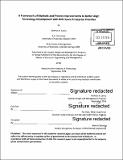A framework of methods and process improvements to better align technology development with DoD space enterprise priorities
Author(s)
Cantu, Kathryn R
DownloadFull printable version (22.33Mb)
Other Contributors
System Design and Management Program.
Advisor
Pat Hale.
Terms of use
Metadata
Show full item recordAbstract
Strong research and development planning is critical to ensuring the necessary technologies have been matured for future acquisition programs. For the DoD Space Enterprise, research and development occur across a myriad of government laboratories, Federally Funded Research & Development Centers, other government agencies, academia, and industry. This work is governed through many different processes, but improvements could be made to the communication, collaboration, cooperation, and coordination through a well aligned governance structure. The use of Model-Based Systems Engineering, Technology Roadmapping, and Design Structure Matrices can transition the DoD to an approach that documents the capability needs, priorities, timelines, and system interdependencies in a way that facilitates knowledge sharing and cooperative, coordinated system planning. This process would begin by developing a solution-neutral functional architecture and decomposing the technology needs against the planned future acquisition timelines in a technology roadmap that integrates all space mission areas. A streamlined process with distinct functions, each chaired by a single enterprise authority, executed by a space community chief architect, and with participation by the relevant stakeholders, can lead to a portfolio management process that aligns technology development with enterprise priorities. The integrated roadmap can be used to communicate transparently with all R&D entities so that investment decisions can be aligned with the future acquisition needs. This approach will take best advantage of the incredible research that is occurring throughout the country for space systems, and ensure that the right technology is being shepherded for on-orbit demonstration at the right time.
Description
Thesis: S.M. in Engineering and Management, Massachusetts Institute of Technology, School of Engineering, System Design and Management Program, 2016. "September 2016." Cataloged from PDF version of thesis. Includes bibliographical references (pages 94-100).
Date issued
2016Department
Massachusetts Institute of Technology. Engineering and Management Program; System Design and Management Program.Publisher
Massachusetts Institute of Technology
Keywords
Engineering and Management Program., System Design and Management Program.